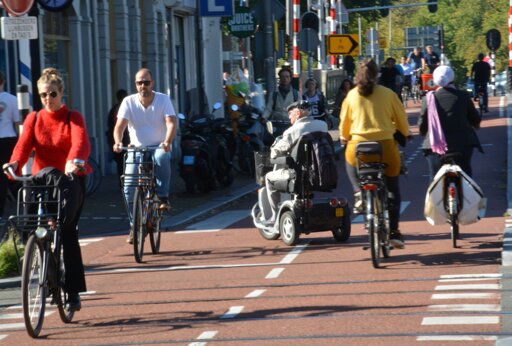- cross-posted to:
- [email protected]
- cross-posted to:
- [email protected]
It appears a lot of you think that cyclists should be restricted to pedestrian speeds.
There are already sidewalks that are usable for mobility scooters and wheelchairs. Forcing them to use cycle paths is forcing them into unsafe areas.
On the contrary, in my experience there are no sidewalks or bicycle lanes or shoulders on the road. So what might be a terrible goal in relatively alternative-transportation-friendly spaces could also be a massive step up for other locations.
I’m sorry, but I’m pretty sure that most wheelchairs and mobility scooters aren’t designed to handle going at 20km/h+ for long distances. Not to mention that they’re wider than bikes.
This is horribly naïve and is just turning bike lanes into extended sidewalks because someone doesn’t want to walk around disabled people. Instead, make sure that sidewalks are wide enough for people to walk anything wider than single file. Side walks and bike lanes are only a fraction the cost of normal roads, support far more people, and increase local businesses because a car’s not gonna park every two blocks to buy a coffee then a single t-shirt, then a new notebook before going to work, but pedestrians and cyclists can and do easily do this.
I brought this up a few days ago.
It only makes sense to allow wheelchair and mobility scooter access to “bike lanes” (i.e. realistically, Multi-use paths), so that it actually remains protected and there’s some legal fist that forces places to expand on their networks.
They need to be wider by design, never mind this 1m bullshit when cars come within inches of hitting you. Give us “bike lanes” that are the width of a single car lane. That’s not asking for much.
Shared bike/pedestrian paths tend to be dangerous for both, because pedestrians tend to take up the whole width or jump right into the path of a bicycle or scooter.
Shared bike/pedestrian paths tend to be dangerous for both, because pedestrians tend to take up the whole width or jump right into the path of a bicycle or scooter.
Anecdotally, yes, I’ve experienced that happening.
Whether it’s statistically true that shared multi-use paths are more dangerous, I’m not sure. Data does suggest that wider is better.
But in my experience, conflicts are common when you have narrow shared pathways, or have shared infrastructure in places where bike/pedestrian paths aren’t normalized.
We have a section of trail along our waterfront that splits into a pedestrian and cycle path (dual lane) that’s separated by several meters of grass, bushes, and trees. This is well away from any roadways.
While this might seem ideal, I can’t tell you how many times you get cyclists in the pedestrians on the wrong path, which creates even more conflicts because you’re expecting the separation.
Granted, there are parts of the world that have different forms of cyclist/pedestrian separation that I don’t have here, so I can’t comment to how effective other forms of trail design are.
Best practice around the world has been “make it as wide as you can”, and also having a centreline seems to reduce conflicts and speeds (interestingly enough!).
When I have experienced conflicts with pedestrians (while I’m riding my bike or e-scooter), it’s almost always because they are distracted, don’t have control of their dog/child, or are walking in a group of more than 3 people and taking up both lanes of the pathway. I rarely, if ever, experience conflicts in sections where the path is wide.
But perhaps the caveat of my experience is that I cycle defensively, always ring/call out when I pass, and never speed past pedestrians.
The issue here sounds like is caused by the separation itself being physical. If you start at one side, even if you realize you made a mistake, you can’t correct it until you reach a point where the there’s a crossing or some sort of merger, causing more issues.
That’s why all the separated side-walk/bike lanes I know are separated by painted lines instead of grass or trees. It makes it easy to cross one to reach the other and to correct yourself if you started on the wrong one.
Though I admit there’s always bad actors that ignore this, those are by far the minority, and if a cyclist is doing so, they’ll usually give up because they can’t stand being delayed by slower moving pedestrians.
So are you cool with my 90kgs barreling past you at ~30 km/h? Because thats why I want bike lanes and ride on the street when there isn’t any dedicated lanes.
I’m not understanding. Are you saying that even with very wide bike lanes, you would be barrelling down it at 30km/h while other users were nearby?
Wider lanes doesn’t mean that we become inconsiderate. Wider lanes make things more accessible to a larger user base. We should still be moving along those lanes at a reasonable speed.
Unless I totally misunderstood what you’ve said.
No, I’m saying I use a bike to go fast without a car.
Widening the lane and adding slow moving individuals increases the likely hood of an accident. Also makes the lane less usable by cyclists.
If you want better infrastructure for those with disabilities widen the sidewalk where they are already safe.
The idea of bike lanes was to separate them from cars. How is making it a new sidewalk an improvement?
My friend, there are already slow cyclists in the bike lane. They will remain there, because they have the right to it by definition. Adding other kinds of small mobility vehicles with similar speeds is not materially going to impact us faster cyclists, as long as the bike lane is of sufficient width for us to safely pass them. This is coming from another 90 kg/>30 km/h rider who often has to use the main road for practical reasons.
In fact, I tend to use the main road over available bike lanes specifically when the width of the bike lane is insufficient for passing slower cyclists in a safe manner. The other reason I skip the bike lane is when it is designed in an unsafe manner, such as ending abruptly and forcing conflicts with pedestrians, or when it crosses turning lanes in a manner where drivers cross the lane without looking.
So, lets see. So far in this thread cycle paths should be wide enough for an emergency vehicle, should be used by all manners of transport other than automobiles and speed restricted due to slow moving scooters and pedestrians.
Sounds like it removes all the benefits and adds all the problems of the system we currently have.
I don’t think they should necessarily be speed restricted, nor is that the law where I live - the only rule is that you can’t exceed the speed limit on adjacent roads (which practically makes them unbounded for almost all cases for cyclists under their own power).
By making them wide enough for emergency vehicles, they can accommodate both slower and faster moving cyclists, with mobility vehicles moving at similar speeds to slower cyclists and hence automatically being accommodated. I don’t think pedestrians should be co-located with cyclists and mobility vehicles, as these actors have different incompatible needs.
No, I’m saying I use a bike to go fast without a car.
For sure, but bike lanes (of any width) aren’t really designed for fast bikes. Granted, wide bike lanes (like in some areas in Montreal) would accommodate fast cyclists because you have a ton of space to pass slow riders.
Widening the lane and adding slow moving individuals increases the likely hood of an accident. Also makes the lane less usable by cyclists.
But we currently have the same users on very narrow lanes… how would widening it make the problem worse?
Yes, we would be inducing demand, but with wide lanes, this would be a non-issue.
If you want better infrastructure for those with disabilities widen the sidewalk where they are already safe.
In a perfect world, yes, I agree. Unfortuantely, you can’t have wide sidewalks and wide bike lanes and wide roads. There’s just not enough room or money for that.
If you build a very wide “bike lane” that replaces a sidewalk and standard bike lane at the same time, you can build more of them, and they’d be safer than having a narrow bike lane and narrow sidewalk.
The idea of bike lanes was to separate them from cars. How is making it a new sidewalk an improvement?
You’re still separated by more space :)
Ok, in this context, I don’t think that anyone is proposing simply building a wider bike lane next to cars. The ideal would be to do what other cities have done (Paris, Montreal, various cities in the Netherlands, etc.) and build “wide bike lanes” that are actually regular roads with no car access.
If you frame it as a need for cyclists, you get very little support (in fact, you get push back from NIMBYs and carbrains). However, when framed as an accessibility right for people in wheelchairs and mobility scooters, then you have more legal obligations to build this infrastructure up, and cyclists win at the same time.
I think there’s a disconnect of what people mean by fast and slow here. A slow cyclist is still going at 15km/h, and 30km/h isn’t even that fast, more comparable to a jogger than a sprinter for pedestrians.
Whereas electric wheelchairs are optimized to move within walking speeds, so about 4-6km/h. Having someone move 5km/h share space with someone going 20km/h+ is like having roads that share 60km/h with those going at 20km/h. Anybody would agree that it’s unsafe for such a discrepancy on a road, so why isn’t it also true on bike lanes?
Not to mention that some bike lanes are actually too narrow for wheelchairs to fit. I know some that are less than one meter wide because our city sucks and we’ve had mayors do their best to abolish bike lanes while others try to bring them back, only for the premier to try his turn to abolish them. Imagine trying to fit anything but a bike when you’re flanked with concrete walls about 70cm apart?
Though I also admit, some sidewalks are hardly any better, and there’s entire sections of the city that have zero side walks as well, but those areas also have zero bike lanes despite allowing cars to go 40km/h or even higher.
I think there’s a disconnect of what people mean by fast and slow here. A slow cyclist is still going at 15km/h, and 30km/h isn’t even that fast,
What’s the context? Country bike lane or urban trail? 30km/h on an urban bike trail is too fast. That’s why places that do post speed limits for cyclists often have them at 20km/h or slower.
Whereas electric wheelchairs are optimized to move within walking speeds, so about 4-6km/h. Having someone move 5km/h share space with someone going 20km/h+
I disagree. If you’ve even been in a sufficiently wide bike track, you’ll realize there are no real conflicts.
The issue is that very few tend to be very wide, so any conflict is a result of the design, and not the concept.
is like having roads that share 60km/h with those going at 20km/h.
Yes, a single, narrow road in that scenario would create bottlenecks. Although, this is common on roads where farm equipment is used.
The more accurate comparison would be a multi-lane road where slower drivers are on the right side, while faster drivers are on the left. They have enough width over those multiple lanes to avoid conflicts.
We’re asking that bike lanes be sufficiently wide to also avoid conflict.
Not to mention that some bike lanes are actually too narrow for wheelchairs to fit.
100% agreed. Too narrow for bike trailers, cargo bikes, trikes, and mobility scooters.
That’s why we need laws that make it mandatory to have WIDE lanes for these users.
there’s entire sections of the city that have zero side walks as well, but those areas also have zero bike lanes despite allowing cars to go 40km/h or even higher.
We have a few places like that around here. It’s unnerving to say the least, and I wish they were only going 40km/h… I’ve clocked cars and large trucks going well over 80km/h (in 50km or 60km/h zones) as I white-knuckle through on my bike.
Alright, I see the disconnect here. You’re talking about rural bike lanes as well as park paths. I’m talking about city bike lanes where you have about 12 meters to work with before you’re up against buildings on both sides half the time.
In that context, there’s only so much you can do to widen lanes, and usually that’s only possible by removing lanes for other modes of transit.
Frankly speaking, bike lanes of other areas have to go based on different standards as they exist for different purposes, so I’ve been isolating entirely to typical city streets.
Most of the sidewalks plus bike lanes in Toronto at least tend to only add up to about five meters in width at most, with plenty being only three meters wide together (two for the sidewalk, and one for the bike lane), with streets being between one or two lanes for the most part, excluding certain major streets.
In this context, it’s crazy to think about bikes and wheelchairs sharing space together. And to be frank, even if the space was double that, I think the difference in typical speed makes such considerations still crazy. Just because some mobility scooters and electric wheelchairs are physically able to go as fast as a slow bike, doesn’t mean that it’s safe for them to share space.
If you can somehow make bike paths on the roads at least four meters wide, then sure, we can talk about that. But I’ve never seen such a thing anywhere in my city. Anything wider than 1.5 meters is simply doesn’t exist, and that is far too narrow to allow both forms of travel to share space safely.
That’s better than 3500kg at 60km/h.
Cool, so this causes more problems than it solves
Bike lane protected by concrete that are level with the ground are easier for mobility device users than uneven sidewalks which constantly cross roads.
I see this all the time and it is unacceptable.
Your photo shows a wheelchair using a plowed roadway, because the sidewalk isn’t plowed
Bike lane protected by concrete…
… isn’t going to be plowed either. The only reason a regular bike lane is plowed is because it is part of the roadway.
And that person should have a sidewalk. You want to put pedestrians in with cyclists.
Edit: cycle paths cross roads just as much as sidewalks
Make bike lanes wide enough so that they can be used by emergency vehicles!
So, a full lane.
Most emergency vehicles have been getting wider.
They don’t need to be getting wider though. Many European models fit down tight streets with ease and carry all the same gear.
They still need a full lane.
Sure why not. And protected from car traffic.
Honestly, I’d like everyone to take back the road. Enforce lower speeds in streets AND in bike lanes. I don’t mind bikes in the streets and runners in bike lanes, so long as we limit speeding on both so they can safely coexist.
So, what’s your ideal speed?
Edit: lots of hate and no answers.
Edit 2: can no-one answer what speed this magically wide all use lane would be restricted to?
30km/h is typical on shared streets like that. That doesn’t fix the issues on the connecting streets tho.
30 km/h and city centres should have no access except for vehicles with deliveries.
Where I live, that seems like a truly terrible idea.
Cyclists move really quickly and are somewhat reckless and selfish as they try to maintain their speed and momentum in traffic. It barely works with cars despite the dedicated lanes. It always causes problems anywhere that bike and pedestrian traffic meets, especially in areas n like temporarily diversion or construction.
I support bike lanes and, for quite a while, I use them extensively biking from the suburbs to my work downtown. I was probably the same.
We should not place slow-moving ( and vulnerable ) traffic in the path of cyclists. We do not need grandma or a paraplegic getting wiped out by a 180 pound guy going 25 km an hour.
You could try to make the bike lane massively wider. This would be a poor use of space. It would greatly increase congestion and the “slow alternative vehicle lane” would be almost empty all the time. It would be 30 empty wheelchair parking spots at the mall while cars get in accidents trying to find a spot but worse.
Of course, out of the city, things are different. My family enjoys a nice bike ride every Sunday on a local road that has quite a wide lane running side it that pedestrians, wheelchairs, scooters, and cyclists share. The lane is wide enough and traffic density is low enough. There are no buildings to move so, the “road” got wider with the extra lane rather than space for cars being reduced.
deleted by creator
I fully agree. Also if your bike lanes are like the ones in my city, these people (wheelchair and mobility scooter users) would find themselves suddenly in traffic. Right where they are in serious danger from cars.







